May 28, 2025 | 12:48 GMT +7
May 28, 2025 | 12:48 GMT +7
Hotline: 0913.378.918
May 28, 2025 | 12:48 GMT +7
Hotline: 0913.378.918
At the Conference "Announcing the Planning for Natural Disaster Prevention and Control and Irrigation for the 2021–2030 Period, with a Vision to 2050" taking place in March 2024, the Ministry of Agriculture and Rural Development (MARD) proposed that the Hanoi City People's Committee immediately research the construction of two water-raising dams on the Red River in the Xuan Quan area (Van Giang district, Hung Yen) and Long Tuu (Dong Anh district, Hanoi), expected to start construction in the 2026–2030 period. Talking with the Vietnam Agriculture Newspaper, Prof. Dr. Truong Dinh Du, former Deputy Director of the Institute for Water Resources Research (now the Vietnam Academy for Water Resources - VAWR), shared scientific and practical perspectives on this issue.
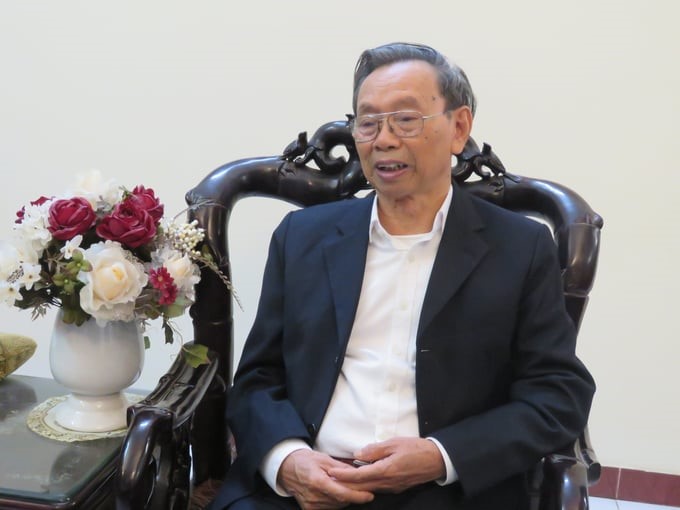
Prof. Dr. Truong Dinh Du, former Deputy Director of the Institute for Water Resources Research (now the Vietnam Academy for Water Resources - VAWR). Photo: MP.
The hot problem with the Red River today is that in the dry season, the water level drops too sharply. In many locations, the Red River water level is sometimes lower than the water-taking sluice threshold and suction tank of pumping stations. Taking a few sluices in the Hanoi area as examples, with the following parameters:
At Long Tuu sluice, the sluice threshold level is +0.00m and the water level entering the sluice is +2.4m, but the Red River water level in the dry season here is only about -0.2m to +1.5m. Or at Xuan Quan sluice, the sluice threshold level is -1m and the water level entering the sluice is +1.85m, but the Red River water level in the dry season here is only about 0.5 m–0.8 m. Therefore, there are times when the sluice cannot get water or only gets about 20–40% of water.
It is worth noting that in the past, when there were no hydroelectric reservoirs upstream, with the natural flow of the Red River in Hanoi being about 500–600 m3/s, the water level was quite high, from +2m to +2.4m. Currently, with this flow, the water level is only +0.8 m to +1.2m. To have a water level of over +2m, the flow in Hanoi must be more than 2,000 m3/s, meaning four times higher than the old flow.
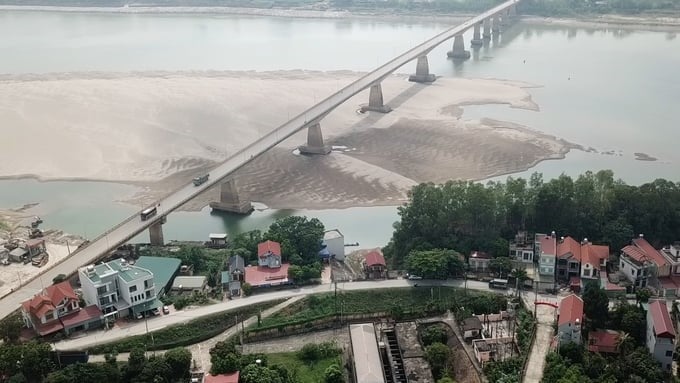
The Red River section flowing through the Trung Ha bridge area (Ba Vi, Hanoi) is dry, causing sand banks to emerge. Photo: MP.
Explaining the reason why the Red River water level is lowered, Prof. Dr. Truong Dinh Du, former Deputy Director of VAWR, summarized as follows: Around 2003, some researchers assumed that the lowering of the Red River water level was caused by factors including the retention of water upstream, climate change, declining forest vegetation, and hydroelectric power plants that did not discharge enough water according to design.
However, not agreeing with the above reasons, in 2004, I proposed to the Ministry of Science and Technology the topic "Drought Prevention Solutions for the Red River Delta," which was accepted and implemented from 2007 to 2010 and chaired by Assoc. Prof. Dr. Tran Dinh Hoa.
When implementing the topic, actual documents showed that the flow of water discharged from upstream to downstream remained at the old level, but the water level is still lowered. Thus, it was affirmed that the Red River's water level lowering is not due to a lack of water flow but rather to the lowering of the river bed. Therefore, we focused on researching the cause of the river bed lowering, initially tilting towards the phenomenon of clear water erosion, also known as the phenomenon of spreading river bed erosion due to retained alluvium after the construction of upstream reservoirs.
After that, Prof. Dr. Vu Tat Uyen, Vietnam's leading river scientist, commented: "Free sand exploitation may be an important cause of the phenomenon of lowering the Red River bed. Following this direction, VAWR's National Key Laboratory of River and Ocean Engineering has been assigned to carry out a State-level independent topic, "Research on the Effects of Sand Exploitation on the Flow Regime and River Bed Developments and Proposals on Scientific and Technological Solutions for the Management and Planning of Reasonable Sand Exploitation on the Red River and Thai Binh River Systems," chaired by Assoc. Prof. Dr. Pham Dinh and deployed from 2013 to 2015.
Research results from VAWR showed that there are two causes of the river bed lowering, including the phenomenon of clear water erosion behind the upstream hydroelectric reservoir and the free sand exploitation along the river that took a large amount of sand from the river bed. These causes have been recognized by everyone, which is the scientific basis for VAWR’s proposal on the construction of water-raising dams at two locations: downstream of the Xuan Quan sluice and downstream of the Long Tuu sluice, after completing the first phase of research. Next, the Yen Lenh water-raising dam in Hung Yen, the Co Le water-raising dam in Nam Dinh, and the water control dam in the Ba Lat estuary area will be built in turn.
At the end of the research phase, the topic recommended prioritizing the construction of two dams, Xuan Quan and Long Tuu. These two works must be built at the same time to ensure the calculated flow rate between the Red River and Duong River. The remaining three dams will be built later. But this proposal has not been accepted because there has been no planning yet.
Next, VAWR was assigned to carry out the topic "Comprehensive Research on Solutions for Water-Raising Dams to Cope with the Water Level Lowering and Ensure Water Source Security in the Lowlands of the Red River," carried out from 2015 to 2018 and also chaired by Prof. Dr. Tran Dinh Hoa.
After calculating the water surface of the Red River and its tributary rivers, the topic proposed ten water control dams at locations on the Red River system as follows: (1) Thao-Da interflow dam, (2) Xuan Quan water-raising dam (Red River), (3) Long Tuu control dam (Duong River), (4) Ba Lat water source control dam (Red River), (5) Ninh Co River water source control dam, (6) Day River water source control dam, (7) Tra Ly River water source control dam, (8) Hong Quynh water source control dam (Hoa River), (9) Do Han water source control dam (Do Han River), and (10) Luoc River water source control dam.
After this second study, the State still has no guidelines for building water-raising dams on the Red River but still maintains the solution of increasing the amount of water discharged from upstream hydroelectric reservoirs three times at the beginning of the dry season every year to serve the winter-spring crop, with a total volume of about 4-5 billion m3 of water.
In my opinion, this solution has the advantage that the State has not had to invest anything but can solve the problem of water supply for about 650,000 hectares of the winter-spring crop through existing irrigation structures, ensuring winter-spring crop production in the Red River Delta. Therefore, when there is no solution for water-raising dams on the Red River, this is the only solution necessary. But this solution has the following basic disadvantages:
First, in addition to the days of increased water discharge, there are more than 5 months in the dry season when the Red River’s branches and the canal system of irrigation structures taking water from the Red River are depleted to the bottom, causing severe environmental pollution in villages and urban areas in the Red River Delta, especially in the Hanoi capital, with many river branches stinking.
Second, in addition to three increased water discharges to serve the winter-spring crop during the dry season, the Red River Delta is still in a state of drought, and people are not proactive about water sources for production and daily life while the demand for Red River water has increased significantly compared to before.
Third, this solution causes a large waste of water resources. Every year, about 4.5–5 billion m3 of water is discharged, but only about 1.5 billion m3 of water can be taken into the fields; the remaining about 3 billion m3 of water flows into the sea. Although this amount of water loss was used to generate electricity, the generation did not comply with the plan, so it still caused great damage to the electricity industry.
From my point of view, MARD’s proposal to build water-raising dams to regulate water levels behind the Xuan Quan and Long Tuu sluices is extremely correct for the following reasons:
First, this proposal has a solid scientific basis, which is the research results of three State-level scientific topics previously conducted by VAWR. To be more clear, the cause of the drought in the Red River Delta is a lack of water level that causes the fact that existing works cannot take water, not a lack of water sources. Therefore, the solution of building water-raising structures is the most reasonable.
As for the plan to build pumping stations to combat drought in areas self-flowing from the Red River, it is completely unreasonable because the pumping station can only serve the area it is responsible for, while in the Red River bed, the water level is still lowered, so the Red River's tributary rivers are depleted, unable to supply water for production and daily life. Especially, the phenomenon of depletion in tributary rivers still causes very serious environmental pollution. Thus, the proposed plan of water-raising dams that not only proactively collects artesian water continuously but also solves the overall environmental problem is optimal.
Second, this proposal has high legality because these two works are listed in the Northern Delta plan.

The proposal to build water-raising dams on the Red River has a solid scientific basis, which is the research results of three State-level scientific topics previously conducted by VAWR. Photo: Minh Phuc.
Third, these two water-raising dams will bring high socio-economic efficiency to agriculture and industry in the region. Especially, proactive water sources in the winter-spring crop from beginning to end will help to develop vegetables and livestock. Domestic water will be provided enough for people thanks to the restored underground water source. The ecological environment of residential areas will be better guaranteed, especially the landscape of the Hanoi capital, which will be true to the beauty of the riverside city. Water transportation will be more convenient. Thanks to that, this proposal meets the aspirations of the people in the benefit areas of these two irrigation systems and of the Hanoi capital.
Fourth, the construction of control dams in Xuan Quan and Long Tuu must be carried out at the same time so that the flow rate between the two rivers is guaranteed as prescribed because the Duong River is currently eroded more deeply than the Red River. In the Long Tuu sluice area, the Duong River bed was eroded to a depth of about 9m.
Fifth, it is also recommended that MARD consider the proposal to build downstream water-raising dams, as shown in the research results. Although it is possible to take advantage of rising tides to get water into the fields, in the Hung Yen and Nam Dinh regions, the amount of water entering the sluices from the Red River in the dry season is also significantly reduced. Specifically, people in Noi village, Nam Thanh commune, Nam Truc, Nam Dinh said that in the dry season, the water level of the canal in front of the village has decreased by half for many years.
Sixth, it must be noted that when there are no downstream water-raising dams, the discharge of water from the upstream and the operating procedures of the Xuan Quan and Long Tuu water-raising dams must be done in such a way as to have little impact on the water intake downstream compared to the previous plan of increased discharge from upstream hydroelectric reservoirs.
Seventh, flood control for the Red River belongs to the category of national security, so regulatory works on the Red River have a special requirement to only raise water in the dry season and compulsorily return 100% of the flood drainage section of the natural river bed. This is the basic principle for choosing the solution of building water-raising to regulate water on the Red River.
Eighth, these two water-raising dams bring high socio-economic efficiency, so any delay will result in more damage to the national economy. There have been clear causes of the water level lowering and many options for construction solutions depending on investment ability, including semi-permanent options, quick construction, or low-investment but effective options. Therefore, in my opinion, it should not be delayed until 2030.
Currently, there are many technologies, from simple to modern, that meet the technical requirements for water raising and flood drainage. Following are a few preliminary features:
The first is the fixed submerged dam to restore the river bed level. This is a form made of easily available materials with a level equal to the old river bed level. Thereby, helping to raise the water level to the level when the river bed has not been eroded. This is the proposal of some experts from the Vietnam Association of Large Dams and Water Resources Development. This plan has the advantage of being cheap but has the disadvantage of not being able to regulate the necessary water level, not increasing flood drainage safety, and easily causing river bed changes.
The second is the mobile submerged box-type dam, which is a submerged dam that raises the river bed during the dry season but is relocated and returns the natural river section at the end of the dry season to ensure increased safety in terms of flood drainage ability. This option has the advantage of ensuring flood drainage safety; the disadvantage is that it must be disassembled every year and cannot regulate the water level.
The third is the submerged box-type dam with clape valve gates. The dam consists of a cuboir bottom slab located underground on the river bed, with valve gates installed on it. Clape valve doors can be made in plate form and controlled by hydraulic cylinders. When raising the water level is needed, press the control button to raise the valve gate to the necessary level. At the end of the dry season, press the control button to lower the valve gate close to the bottom. This type of water-raising dam is modern and convenient to operate.
The fourth is the mobile box-type dam combined with electricity generation. This is a modern type of water-raising dam that can install low-head turbines and generate electricity during the six months of the dry season. At the Xuan Quan dam, it is estimated to generate about 7 MW of electricity.
The fifth is the pillar-type water-raising dam combined with serving as a traffic bridge. In places where the dam location is close to the traffic axis, it is necessary to combine a water-raising dam with a bridge, but the valve gate should have approximately the same width as the bridge span, about 60m, to avoid affecting the flood drainage ability.
Hopefully, in the coming time, a system of water-raising dams on the Red River will exist to resolve the above-mentioned shortcomings.
Translated by Thu Huyen
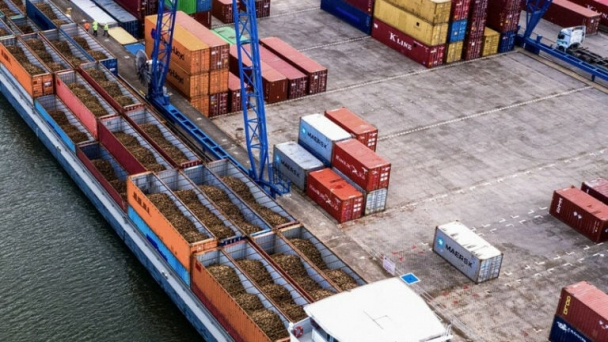
(VAN) The mutual export of agrifood products between the European Union (EU) and the United Kingdom (UK) must occur again without certification, border controls or other red tape. This was agreed at the UK-EU summit.
/2025/05/22/5121-2-173645_677.jpg)
(VAN) NBSAP Tracker identifies strengths and areas for improvement in the National Biodiversity Strategy, based on each region’s priorities and capacities.
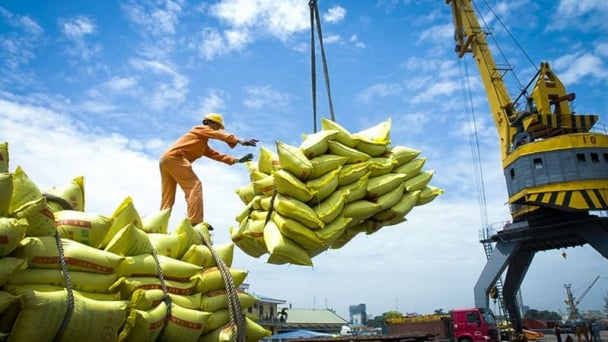
(VAN) The draft amendment to the Circular on rice export trading stipulates a periodic reporting regime for rice exporting enterprises.
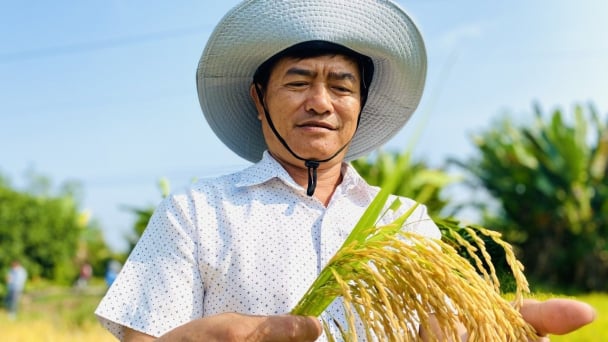
(VAN) Dong Thap farmers attained an average profit margin of 64% during the summer-autumn 2024 crop (first season), while An Giang and Kien Giang farmers followed with 56% and 54%, respectively.
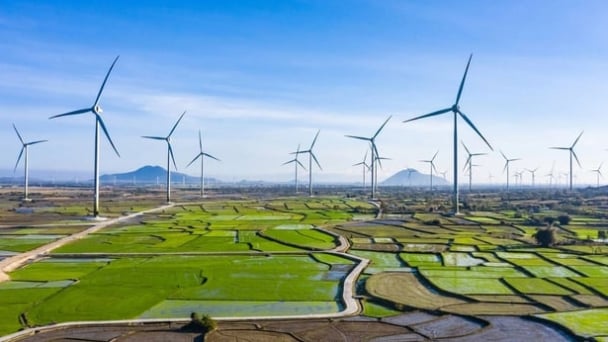
(VAN) As a doctoral student doing research on renewable energy and electrification at Harvard University, the author shares his musings on electricity, nature, and countryside memories.

(VAN) The decree on Extended Producer Responsibility (EPR) ensures transparent management and disbursement of support funds, avoiding the creation of a “give-and-take” mechanism.
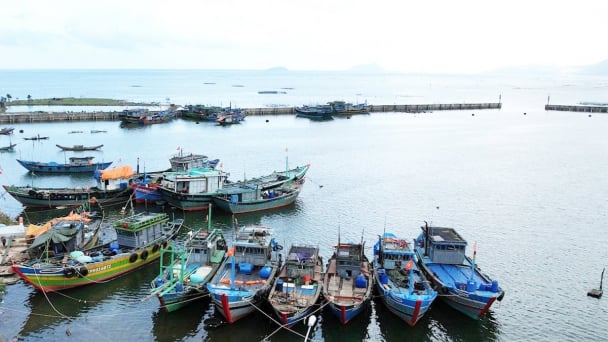
(VAN) Hue City rigorously enforces regulations regarding marine fishing and resource exploitation, with a particular emphasis on the monitoring of fishing vessels to prevent illegal, unreported, and unregulated (IUU) fishing.